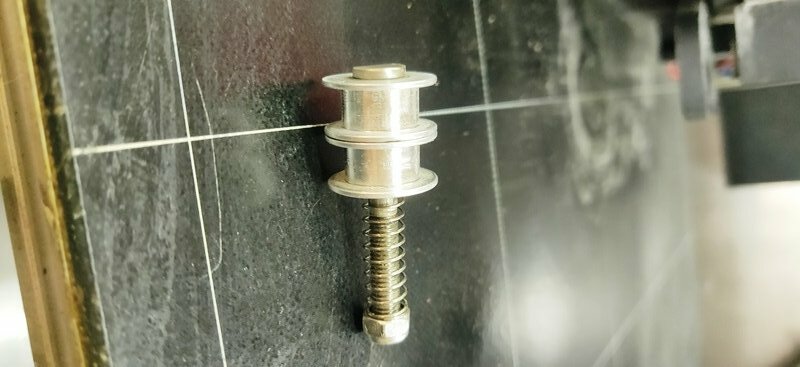Search the Community
Showing results for tags 'dockable'.
-
As a mechanical engineer I spend countless hours working out the mathematics, testing both the theoretical and practical aspects behind the many many ideas that pop into my head. He is a Video of a test of one version of my probe Dockable Probe I was driven to look for a suitable (to me) solution due to other units on offer (in my view) having multiple different issues, with the “popular” magnetic probe in my opinion being stupidly expensive compared to the sum of its parts, or with the likes of the Duet IR sensor which is very particular about reading (or not reading) the data produced by certain print surfaces, then the likes of a BL touch which shits the bed in a decently heated chamber 9anything above 50c), or inductive sensors providing huge reading variances due to reacting badly to temps. This led me into initially designing my own magnetic version of a collectable probe, but I encountered a problem after installing this type of probe in that the hot end and part cooling fan performance was compromised which led to prints failing, I tracked the issue down to a negative interaction between the magnetic field being produced by the fan motor windings being affected by the strength of the rare earth magnets used to hold the two parts of probe together. So that ruled out direct contact magnetic probes which led me on to a simplified version of what I have today. My design criteria were as follows The design must exceed the performance of other products on the market It needs to be inexpensive for the user to put together. It needs to employ readily available components of the same dimensions and standard across the world Its needs to operate in a manner where its presence does not negatively impact the performance of the machine in which it has been installed Parts count needs to be low; I am a great believer in the K.I.S.S methodology So on to the current iteration of my design There are three main printed parts, of a design that can be easily manipulated to allow simple mounting on almost any printer, there are other versions which are designed to fit specific printers such as the voron 2.4 with the stealth burner head. Those parts are printed in PC (ASA would be a suitable alternative) there are the two dock holders and the actuator switch holder. Then there is a simple switch which I modelled using the standard 3d printer end stop switch, with direct actuation on the contactor the switch is more than accurate There are two standard “smooth” idler pulleys used with 6mm belts and have bearing with an I/D of 5mm The actuator shaft can be a shouldered bolt or as my latest version uses a classic American car door hinge pin with is precision ground of a 5mm O/D and has a machined groove that allows a circlip to be attached (this retains the spring) And lastly an easily available 30mm long compression spring with an I/D of 6mm. On to the design If you look at the two idler pulleys, they are both the same and have specific sizes, THE O/D of the main inner surface is 12.15mm and the O/D of the Shoulder section is 17.85mm, the distance between the shoulders is 6.45mm so if you design (and print) the holders for the actuator to a specific tolerance you can achieve the desired goal. The main circular holder part of the dock is printed to be 0.10mm larger in diameter than the pulleys and the fingers of each dock partially encircles back around the pulley and those dimples are 0.10mm smaller in diameter than the pulley, the fingers are designed in such a way that they act like springs, upon entry to the dock the diameter of the pulley spreads these two dimples open allowing the pulley to enter the dock, once fully home the fingers spring to their normal shape and this spring action makes the fingers encircle the pully effectively adding a positive lock retaining action, that design is on both the head portion of the dock and on the storage portion. With regards stability and repeatability, the pulleys diameter and shoulders provide the stability holding the actuator very firmly in place, after the actuator has been “grabbed” and snapped in place, it does NOT matter if there is a minimal amount of lateral movement along the X/Y planes as that is not is what is going to be measured by the probe. Once the actuator has been collected and snapped into place the actuator shaft is forced to move upwards (as either the tool head lowers itself on the print surface in the manner cartesian and delta printers do or in the case of corexy the bed raises and lowers instead) this movement occurs as the actuator contacts the print surface, the actuator shafts O/D is a precision diameter which matches the I/D of the bearing inside the pulley which in this case is 5mm, the very close clearance tolerance between the shaft and the bearing means that things do not tilt on the Z axis plane enough to cause any measurement issue. The actuator is held in tension by its return spring and that tension is held against the precision machined surface of the upper bearing holding everything in a fully vertical position, the whole setup has been designed in such a way so that the distance between the base of the actuator which touches the print surface and physically actuates the end-stop switch means it travels LESS than HALF the distance between the top and bottom bearings, this has been a carefully calculated distance which ensures that the actuator shaft stays vertical throughout its travel during operation. The fact that pulleys have two shoulders which are of a larger diameter than the main retaining diameter means that further stability is ensured and as the distance between those shoulders is 6.45mm and that thickness of the dock itself is 6.35mm there is only a chance of the free play amount being 0.1mm but that is not being measured by the switch so it doesn’t matter, the length of the actuator rod is constant no matter what, and one the trigger height and offset has been calibrated repeatability stays pretty constant to a point of being almost imperceptible with a dial indicator.






